Community Gardens | Transmittal Letter
VerifiedAdded on 2022/09/09
|11
|1743
|19
AI Summary
Contribute Materials
Your contribution can guide someone’s learning journey. Share your
documents today.
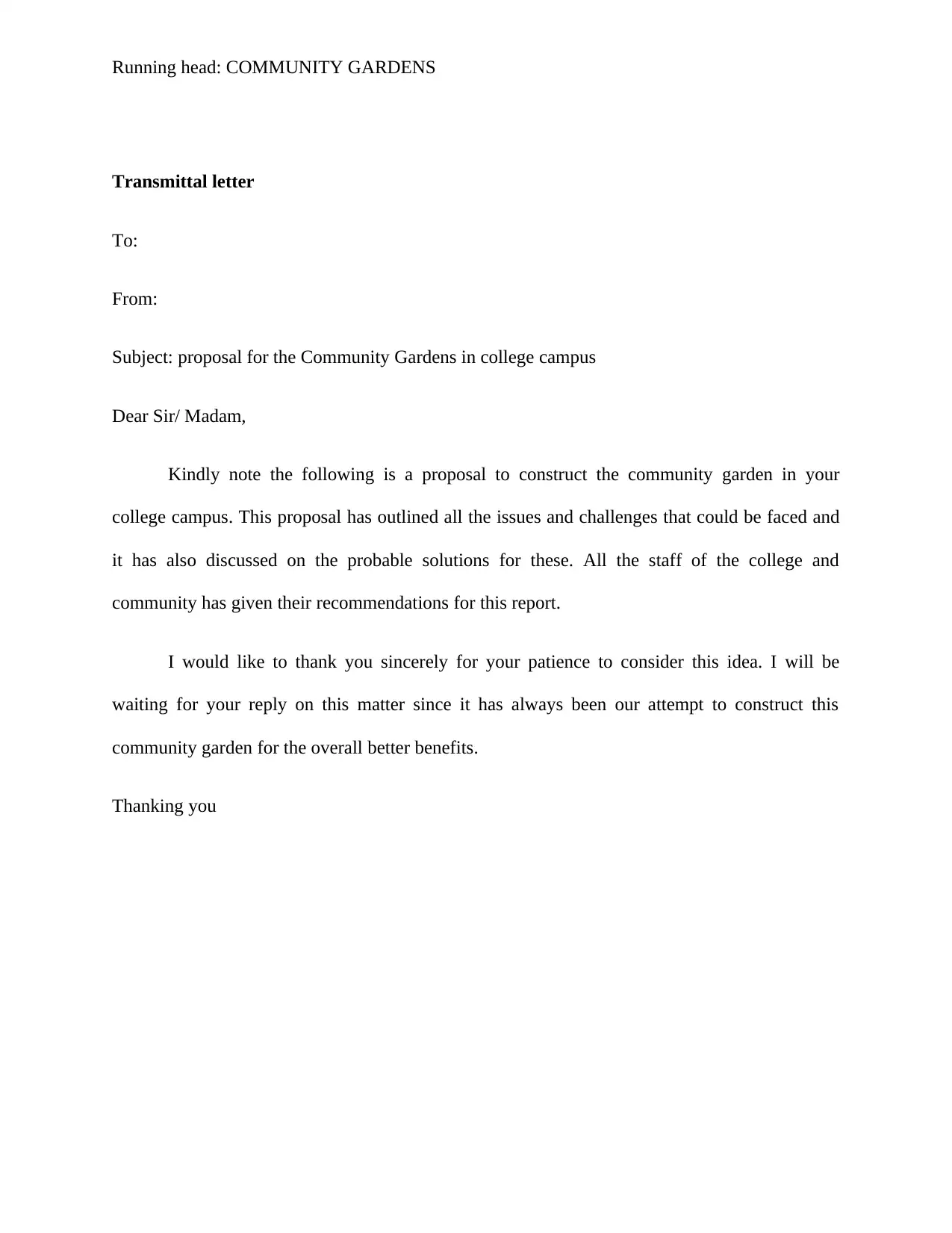
Running head: COMMUNITY GARDENS
Transmittal letter
To:
From:
Subject: proposal for the Community Gardens in college campus
Dear Sir/ Madam,
Kindly note the following is a proposal to construct the community garden in your
college campus. This proposal has outlined all the issues and challenges that could be faced and
it has also discussed on the probable solutions for these. All the staff of the college and
community has given their recommendations for this report.
I would like to thank you sincerely for your patience to consider this idea. I will be
waiting for your reply on this matter since it has always been our attempt to construct this
community garden for the overall better benefits.
Thanking you
Transmittal letter
To:
From:
Subject: proposal for the Community Gardens in college campus
Dear Sir/ Madam,
Kindly note the following is a proposal to construct the community garden in your
college campus. This proposal has outlined all the issues and challenges that could be faced and
it has also discussed on the probable solutions for these. All the staff of the college and
community has given their recommendations for this report.
I would like to thank you sincerely for your patience to consider this idea. I will be
waiting for your reply on this matter since it has always been our attempt to construct this
community garden for the overall better benefits.
Thanking you
Secure Best Marks with AI Grader
Need help grading? Try our AI Grader for instant feedback on your assignments.
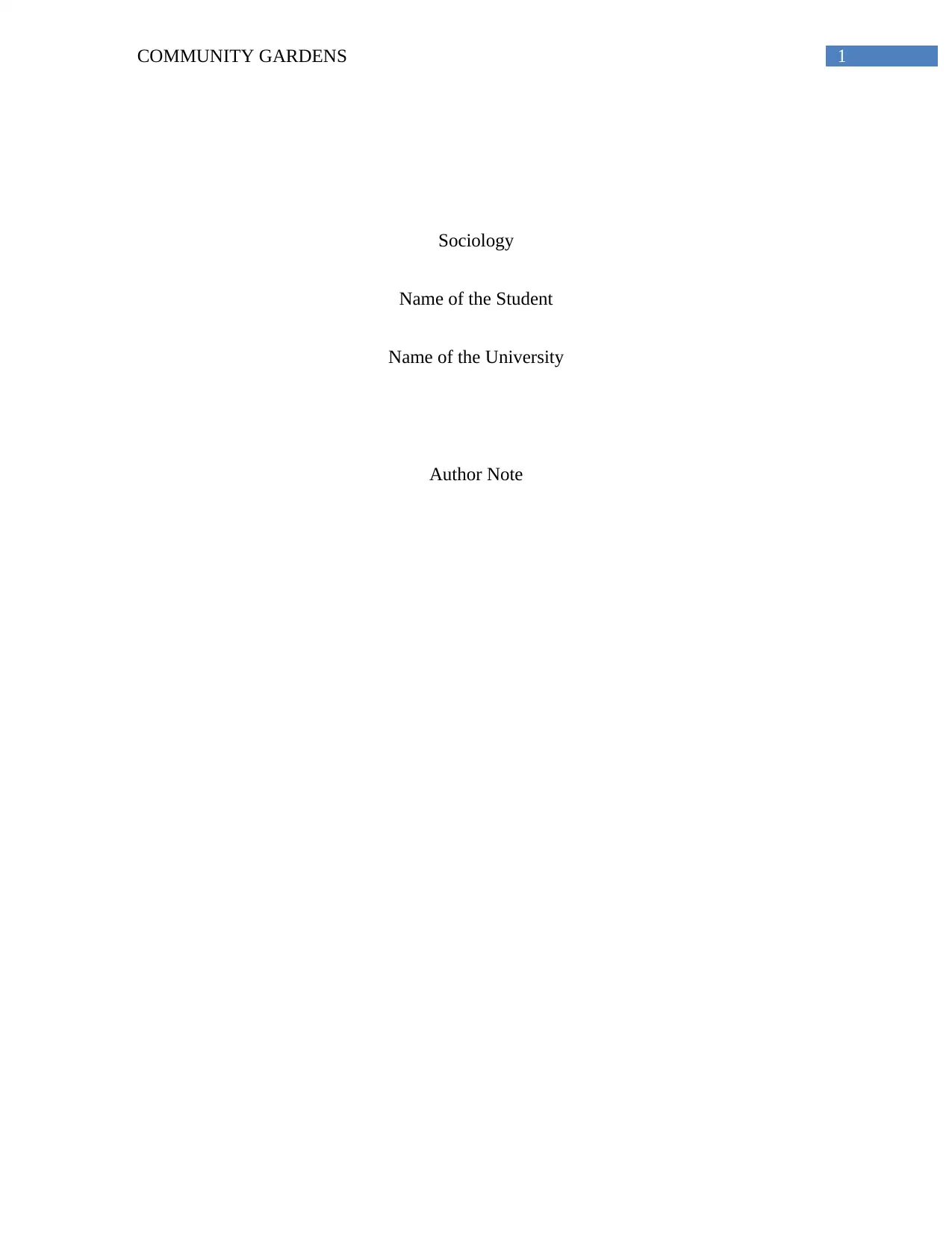
1COMMUNITY GARDENS
Sociology
Name of the Student
Name of the University
Author Note
Sociology
Name of the Student
Name of the University
Author Note
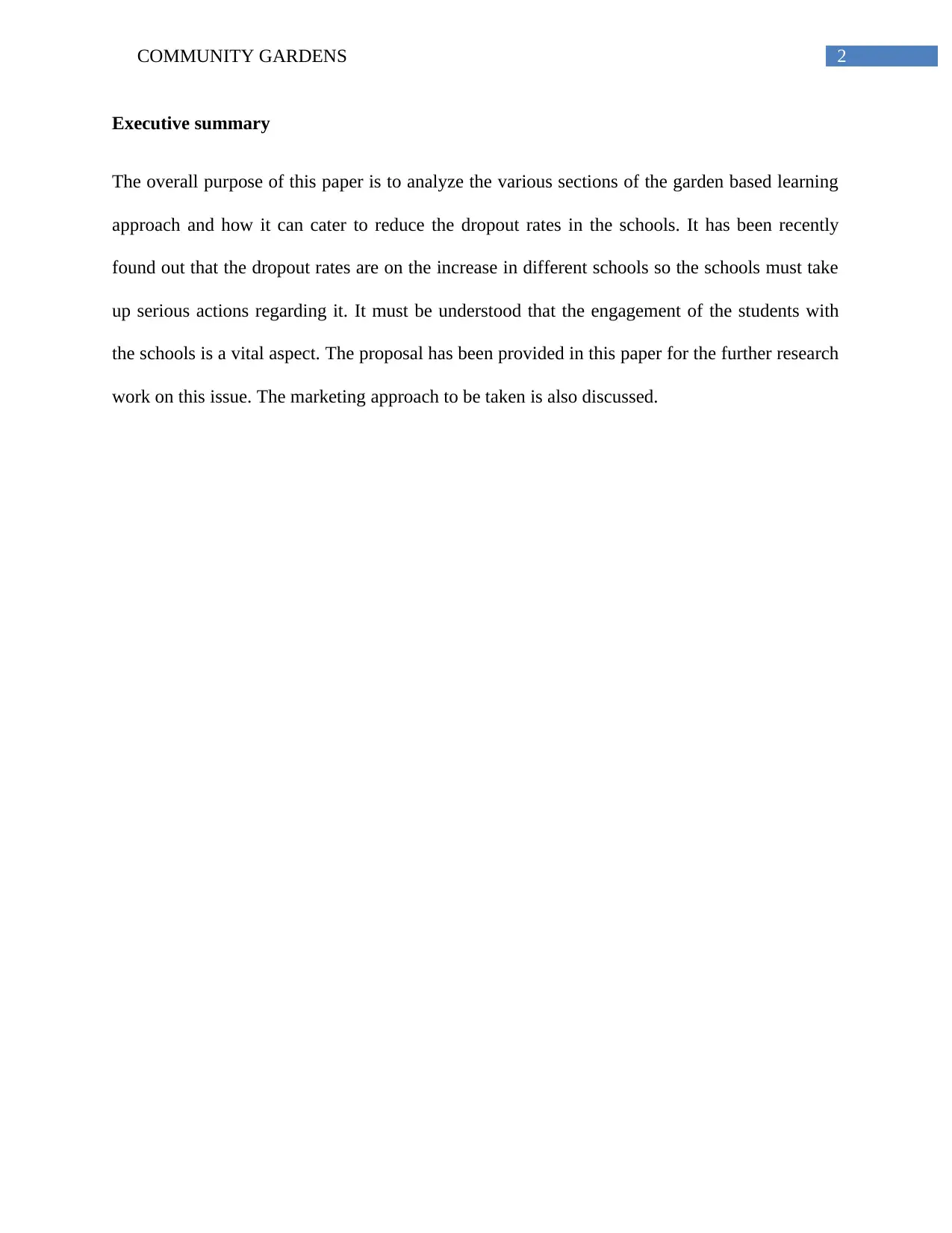
2COMMUNITY GARDENS
Executive summary
The overall purpose of this paper is to analyze the various sections of the garden based learning
approach and how it can cater to reduce the dropout rates in the schools. It has been recently
found out that the dropout rates are on the increase in different schools so the schools must take
up serious actions regarding it. It must be understood that the engagement of the students with
the schools is a vital aspect. The proposal has been provided in this paper for the further research
work on this issue. The marketing approach to be taken is also discussed.
Executive summary
The overall purpose of this paper is to analyze the various sections of the garden based learning
approach and how it can cater to reduce the dropout rates in the schools. It has been recently
found out that the dropout rates are on the increase in different schools so the schools must take
up serious actions regarding it. It must be understood that the engagement of the students with
the schools is a vital aspect. The proposal has been provided in this paper for the further research
work on this issue. The marketing approach to be taken is also discussed.
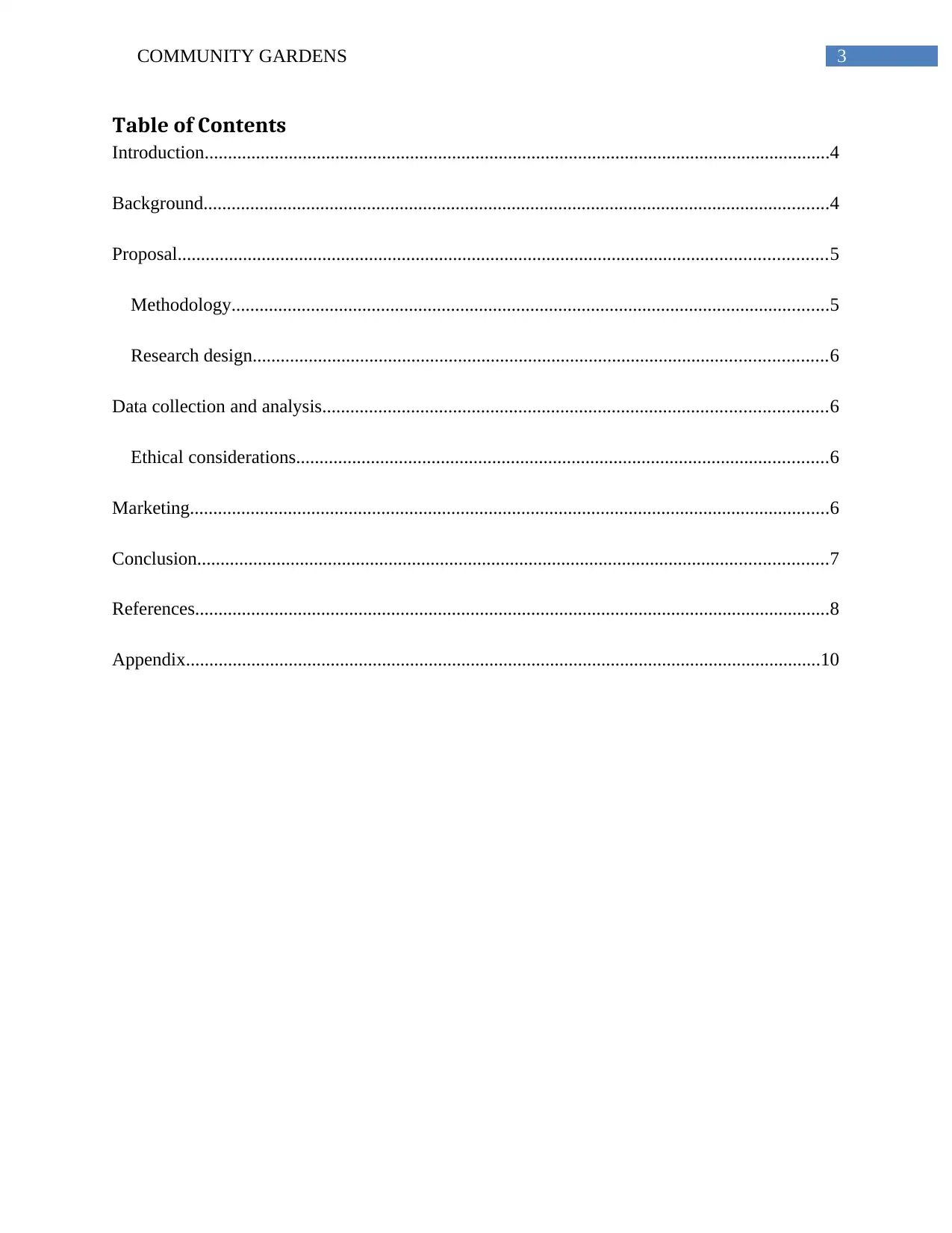
3COMMUNITY GARDENS
Table of Contents
Introduction......................................................................................................................................4
Background......................................................................................................................................4
Proposal...........................................................................................................................................5
Methodology................................................................................................................................5
Research design...........................................................................................................................6
Data collection and analysis............................................................................................................6
Ethical considerations..................................................................................................................6
Marketing.........................................................................................................................................6
Conclusion.......................................................................................................................................7
References........................................................................................................................................8
Appendix........................................................................................................................................10
Table of Contents
Introduction......................................................................................................................................4
Background......................................................................................................................................4
Proposal...........................................................................................................................................5
Methodology................................................................................................................................5
Research design...........................................................................................................................6
Data collection and analysis............................................................................................................6
Ethical considerations..................................................................................................................6
Marketing.........................................................................................................................................6
Conclusion.......................................................................................................................................7
References........................................................................................................................................8
Appendix........................................................................................................................................10
Secure Best Marks with AI Grader
Need help grading? Try our AI Grader for instant feedback on your assignments.
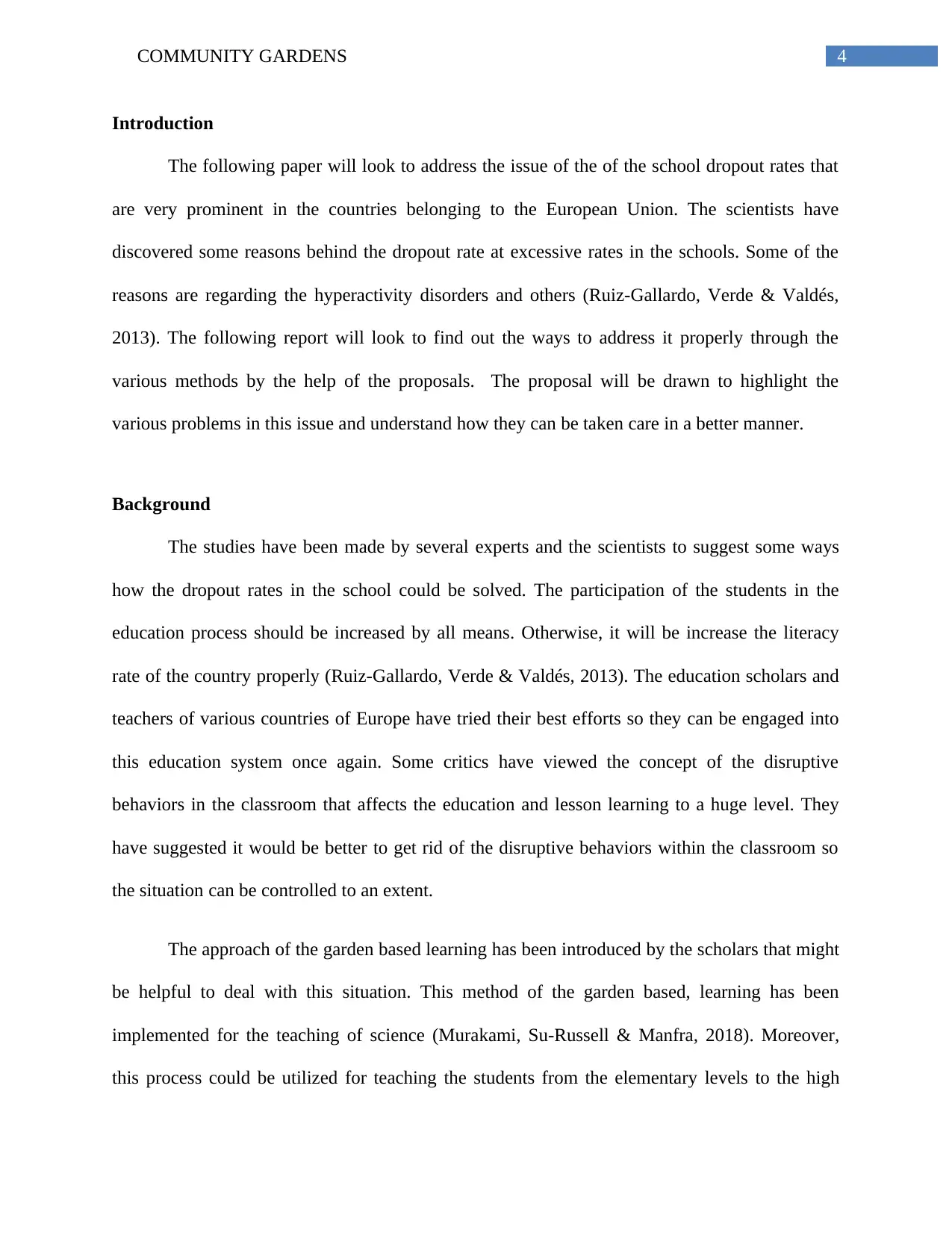
4COMMUNITY GARDENS
Introduction
The following paper will look to address the issue of the of the school dropout rates that
are very prominent in the countries belonging to the European Union. The scientists have
discovered some reasons behind the dropout rate at excessive rates in the schools. Some of the
reasons are regarding the hyperactivity disorders and others (Ruiz-Gallardo, Verde & Valdés,
2013). The following report will look to find out the ways to address it properly through the
various methods by the help of the proposals. The proposal will be drawn to highlight the
various problems in this issue and understand how they can be taken care in a better manner.
Background
The studies have been made by several experts and the scientists to suggest some ways
how the dropout rates in the school could be solved. The participation of the students in the
education process should be increased by all means. Otherwise, it will be increase the literacy
rate of the country properly (Ruiz-Gallardo, Verde & Valdés, 2013). The education scholars and
teachers of various countries of Europe have tried their best efforts so they can be engaged into
this education system once again. Some critics have viewed the concept of the disruptive
behaviors in the classroom that affects the education and lesson learning to a huge level. They
have suggested it would be better to get rid of the disruptive behaviors within the classroom so
the situation can be controlled to an extent.
The approach of the garden based learning has been introduced by the scholars that might
be helpful to deal with this situation. This method of the garden based, learning has been
implemented for the teaching of science (Murakami, Su-Russell & Manfra, 2018). Moreover,
this process could be utilized for teaching the students from the elementary levels to the high
Introduction
The following paper will look to address the issue of the of the school dropout rates that
are very prominent in the countries belonging to the European Union. The scientists have
discovered some reasons behind the dropout rate at excessive rates in the schools. Some of the
reasons are regarding the hyperactivity disorders and others (Ruiz-Gallardo, Verde & Valdés,
2013). The following report will look to find out the ways to address it properly through the
various methods by the help of the proposals. The proposal will be drawn to highlight the
various problems in this issue and understand how they can be taken care in a better manner.
Background
The studies have been made by several experts and the scientists to suggest some ways
how the dropout rates in the school could be solved. The participation of the students in the
education process should be increased by all means. Otherwise, it will be increase the literacy
rate of the country properly (Ruiz-Gallardo, Verde & Valdés, 2013). The education scholars and
teachers of various countries of Europe have tried their best efforts so they can be engaged into
this education system once again. Some critics have viewed the concept of the disruptive
behaviors in the classroom that affects the education and lesson learning to a huge level. They
have suggested it would be better to get rid of the disruptive behaviors within the classroom so
the situation can be controlled to an extent.
The approach of the garden based learning has been introduced by the scholars that might
be helpful to deal with this situation. This method of the garden based, learning has been
implemented for the teaching of science (Murakami, Su-Russell & Manfra, 2018). Moreover,
this process could be utilized for teaching the students from the elementary levels to the high
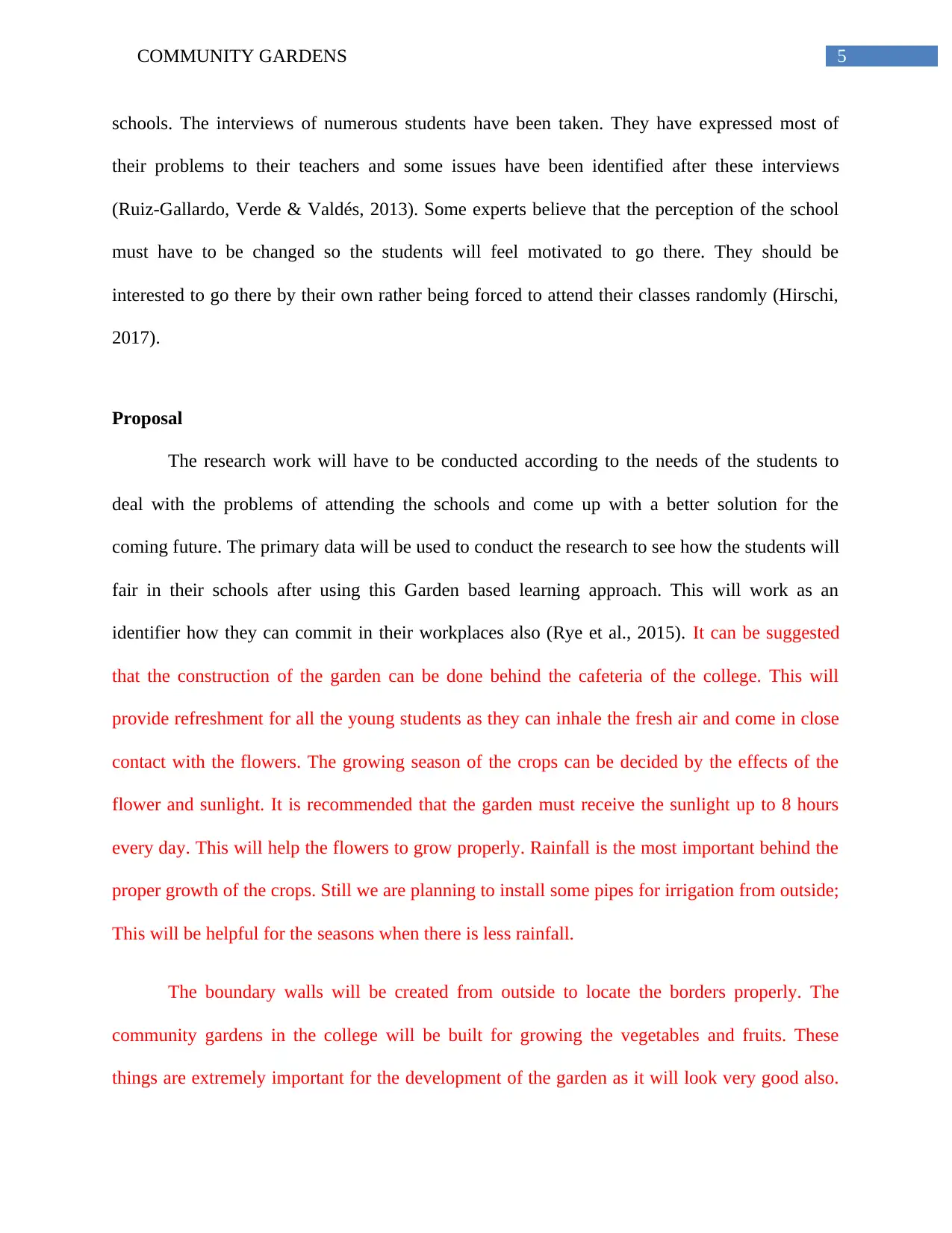
5COMMUNITY GARDENS
schools. The interviews of numerous students have been taken. They have expressed most of
their problems to their teachers and some issues have been identified after these interviews
(Ruiz-Gallardo, Verde & Valdés, 2013). Some experts believe that the perception of the school
must have to be changed so the students will feel motivated to go there. They should be
interested to go there by their own rather being forced to attend their classes randomly (Hirschi,
2017).
Proposal
The research work will have to be conducted according to the needs of the students to
deal with the problems of attending the schools and come up with a better solution for the
coming future. The primary data will be used to conduct the research to see how the students will
fair in their schools after using this Garden based learning approach. This will work as an
identifier how they can commit in their workplaces also (Rye et al., 2015). It can be suggested
that the construction of the garden can be done behind the cafeteria of the college. This will
provide refreshment for all the young students as they can inhale the fresh air and come in close
contact with the flowers. The growing season of the crops can be decided by the effects of the
flower and sunlight. It is recommended that the garden must receive the sunlight up to 8 hours
every day. This will help the flowers to grow properly. Rainfall is the most important behind the
proper growth of the crops. Still we are planning to install some pipes for irrigation from outside;
This will be helpful for the seasons when there is less rainfall.
The boundary walls will be created from outside to locate the borders properly. The
community gardens in the college will be built for growing the vegetables and fruits. These
things are extremely important for the development of the garden as it will look very good also.
schools. The interviews of numerous students have been taken. They have expressed most of
their problems to their teachers and some issues have been identified after these interviews
(Ruiz-Gallardo, Verde & Valdés, 2013). Some experts believe that the perception of the school
must have to be changed so the students will feel motivated to go there. They should be
interested to go there by their own rather being forced to attend their classes randomly (Hirschi,
2017).
Proposal
The research work will have to be conducted according to the needs of the students to
deal with the problems of attending the schools and come up with a better solution for the
coming future. The primary data will be used to conduct the research to see how the students will
fair in their schools after using this Garden based learning approach. This will work as an
identifier how they can commit in their workplaces also (Rye et al., 2015). It can be suggested
that the construction of the garden can be done behind the cafeteria of the college. This will
provide refreshment for all the young students as they can inhale the fresh air and come in close
contact with the flowers. The growing season of the crops can be decided by the effects of the
flower and sunlight. It is recommended that the garden must receive the sunlight up to 8 hours
every day. This will help the flowers to grow properly. Rainfall is the most important behind the
proper growth of the crops. Still we are planning to install some pipes for irrigation from outside;
This will be helpful for the seasons when there is less rainfall.
The boundary walls will be created from outside to locate the borders properly. The
community gardens in the college will be built for growing the vegetables and fruits. These
things are extremely important for the development of the garden as it will look very good also.
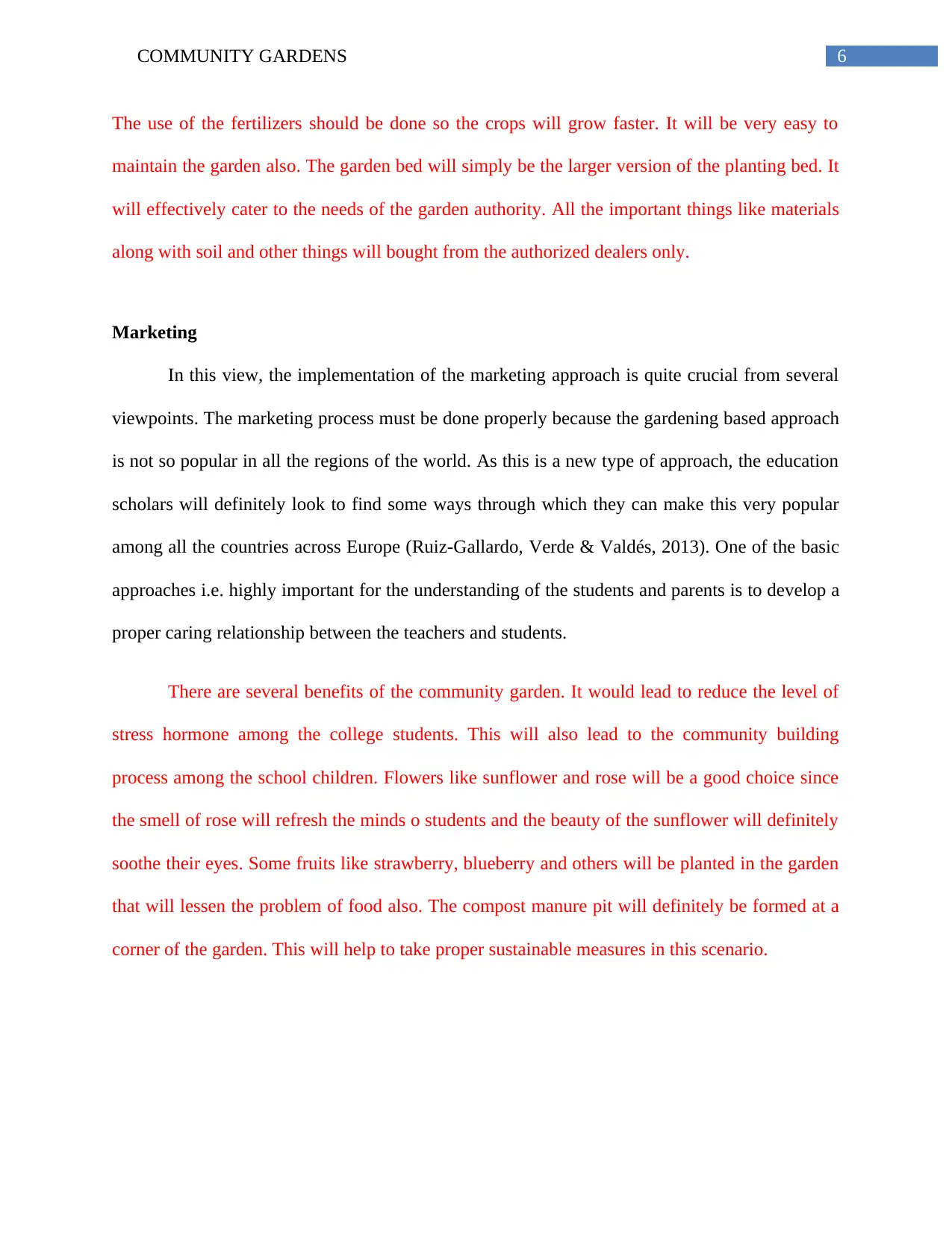
6COMMUNITY GARDENS
The use of the fertilizers should be done so the crops will grow faster. It will be very easy to
maintain the garden also. The garden bed will simply be the larger version of the planting bed. It
will effectively cater to the needs of the garden authority. All the important things like materials
along with soil and other things will bought from the authorized dealers only.
Marketing
In this view, the implementation of the marketing approach is quite crucial from several
viewpoints. The marketing process must be done properly because the gardening based approach
is not so popular in all the regions of the world. As this is a new type of approach, the education
scholars will definitely look to find some ways through which they can make this very popular
among all the countries across Europe (Ruiz-Gallardo, Verde & Valdés, 2013). One of the basic
approaches i.e. highly important for the understanding of the students and parents is to develop a
proper caring relationship between the teachers and students.
There are several benefits of the community garden. It would lead to reduce the level of
stress hormone among the college students. This will also lead to the community building
process among the school children. Flowers like sunflower and rose will be a good choice since
the smell of rose will refresh the minds o students and the beauty of the sunflower will definitely
soothe their eyes. Some fruits like strawberry, blueberry and others will be planted in the garden
that will lessen the problem of food also. The compost manure pit will definitely be formed at a
corner of the garden. This will help to take proper sustainable measures in this scenario.
The use of the fertilizers should be done so the crops will grow faster. It will be very easy to
maintain the garden also. The garden bed will simply be the larger version of the planting bed. It
will effectively cater to the needs of the garden authority. All the important things like materials
along with soil and other things will bought from the authorized dealers only.
Marketing
In this view, the implementation of the marketing approach is quite crucial from several
viewpoints. The marketing process must be done properly because the gardening based approach
is not so popular in all the regions of the world. As this is a new type of approach, the education
scholars will definitely look to find some ways through which they can make this very popular
among all the countries across Europe (Ruiz-Gallardo, Verde & Valdés, 2013). One of the basic
approaches i.e. highly important for the understanding of the students and parents is to develop a
proper caring relationship between the teachers and students.
There are several benefits of the community garden. It would lead to reduce the level of
stress hormone among the college students. This will also lead to the community building
process among the school children. Flowers like sunflower and rose will be a good choice since
the smell of rose will refresh the minds o students and the beauty of the sunflower will definitely
soothe their eyes. Some fruits like strawberry, blueberry and others will be planted in the garden
that will lessen the problem of food also. The compost manure pit will definitely be formed at a
corner of the garden. This will help to take proper sustainable measures in this scenario.
Paraphrase This Document
Need a fresh take? Get an instant paraphrase of this document with our AI Paraphraser
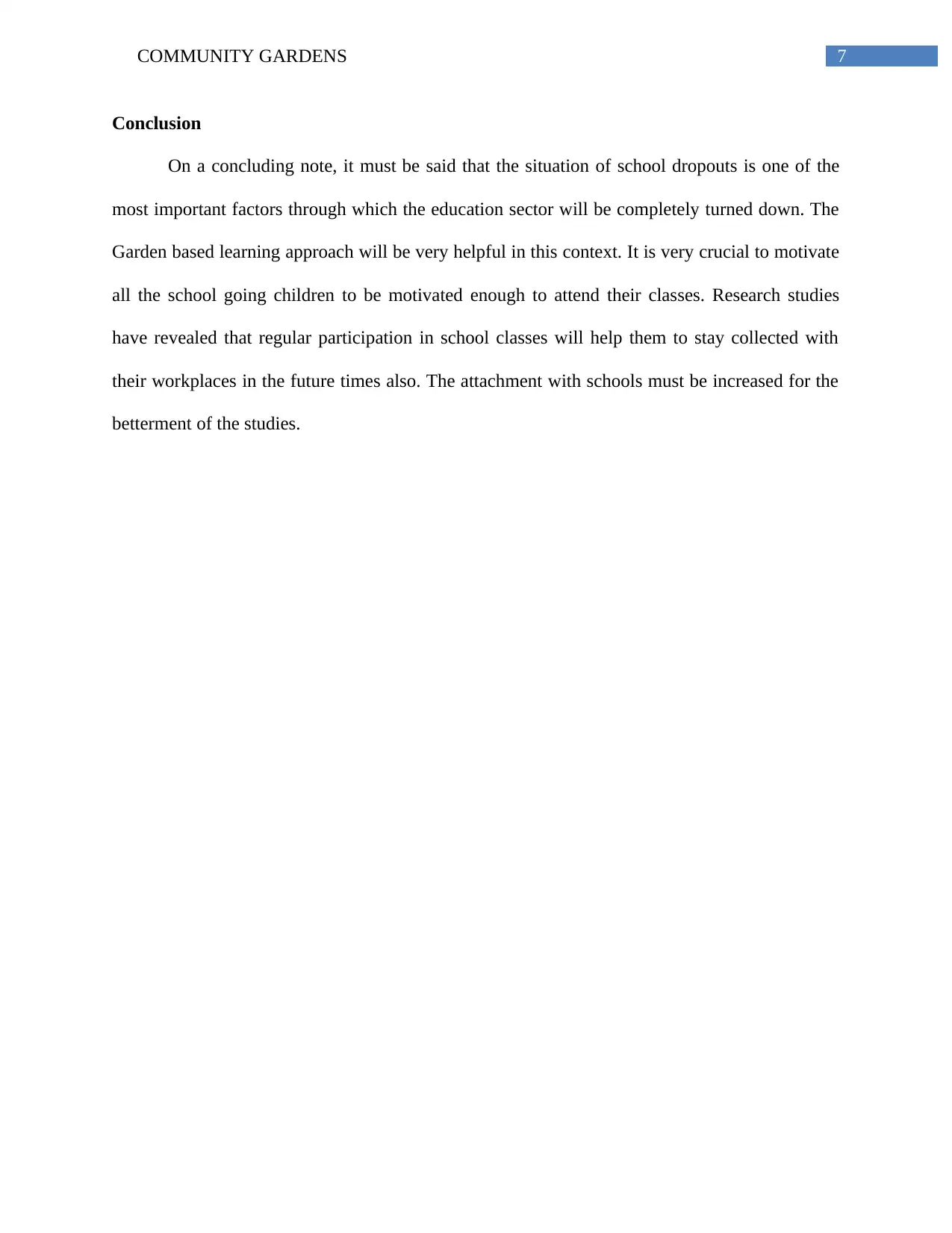
7COMMUNITY GARDENS
Conclusion
On a concluding note, it must be said that the situation of school dropouts is one of the
most important factors through which the education sector will be completely turned down. The
Garden based learning approach will be very helpful in this context. It is very crucial to motivate
all the school going children to be motivated enough to attend their classes. Research studies
have revealed that regular participation in school classes will help them to stay collected with
their workplaces in the future times also. The attachment with schools must be increased for the
betterment of the studies.
Conclusion
On a concluding note, it must be said that the situation of school dropouts is one of the
most important factors through which the education sector will be completely turned down. The
Garden based learning approach will be very helpful in this context. It is very crucial to motivate
all the school going children to be motivated enough to attend their classes. Research studies
have revealed that regular participation in school classes will help them to stay collected with
their workplaces in the future times also. The attachment with schools must be increased for the
betterment of the studies.
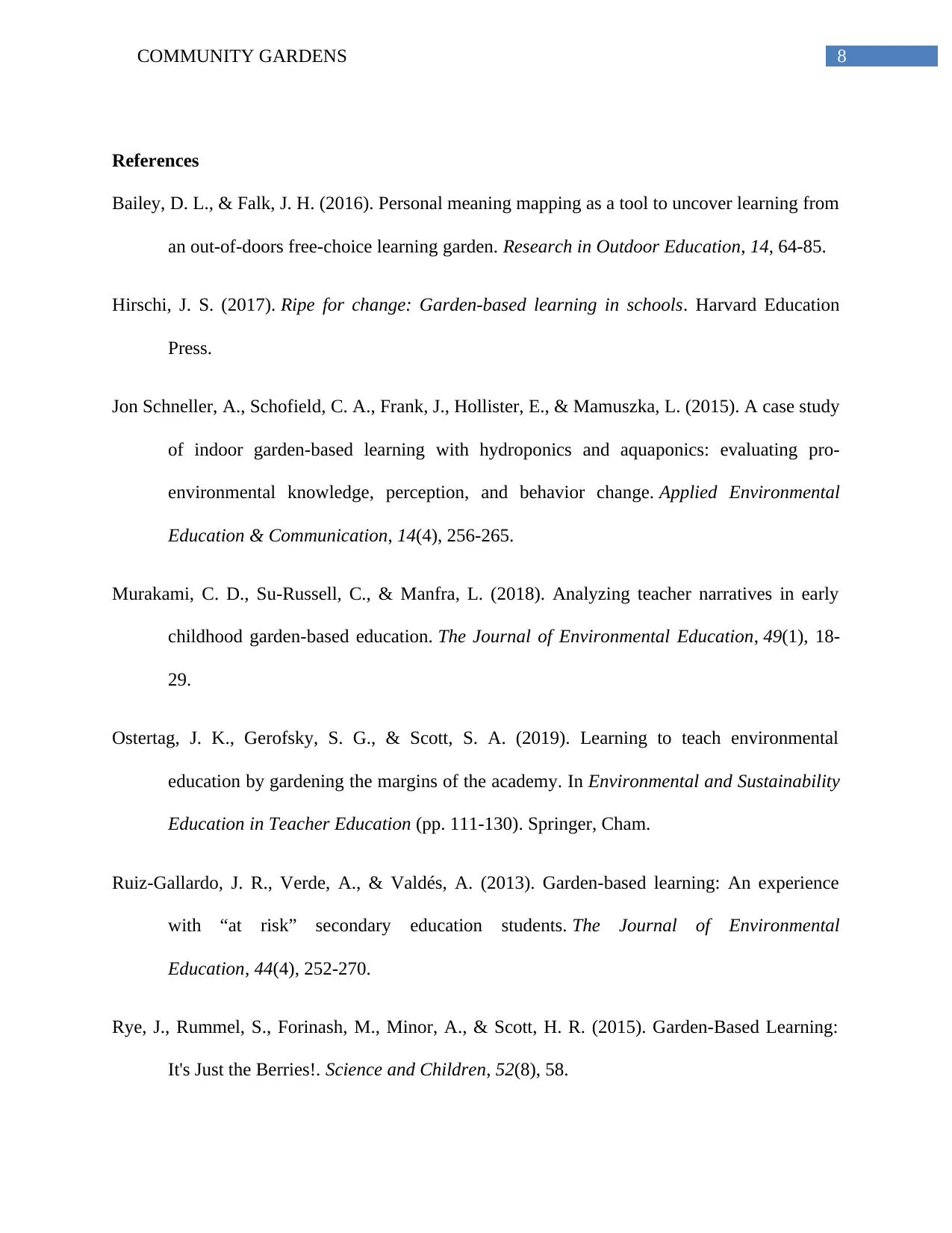
8COMMUNITY GARDENS
References
Bailey, D. L., & Falk, J. H. (2016). Personal meaning mapping as a tool to uncover learning from
an out-of-doors free-choice learning garden. Research in Outdoor Education, 14, 64-85.
Hirschi, J. S. (2017). Ripe for change: Garden-based learning in schools. Harvard Education
Press.
Jon Schneller, A., Schofield, C. A., Frank, J., Hollister, E., & Mamuszka, L. (2015). A case study
of indoor garden-based learning with hydroponics and aquaponics: evaluating pro-
environmental knowledge, perception, and behavior change. Applied Environmental
Education & Communication, 14(4), 256-265.
Murakami, C. D., Su-Russell, C., & Manfra, L. (2018). Analyzing teacher narratives in early
childhood garden-based education. The Journal of Environmental Education, 49(1), 18-
29.
Ostertag, J. K., Gerofsky, S. G., & Scott, S. A. (2019). Learning to teach environmental
education by gardening the margins of the academy. In Environmental and Sustainability
Education in Teacher Education (pp. 111-130). Springer, Cham.
Ruiz-Gallardo, J. R., Verde, A., & Valdés, A. (2013). Garden-based learning: An experience
with “at risk” secondary education students. The Journal of Environmental
Education, 44(4), 252-270.
Rye, J., Rummel, S., Forinash, M., Minor, A., & Scott, H. R. (2015). Garden-Based Learning:
It's Just the Berries!. Science and Children, 52(8), 58.
References
Bailey, D. L., & Falk, J. H. (2016). Personal meaning mapping as a tool to uncover learning from
an out-of-doors free-choice learning garden. Research in Outdoor Education, 14, 64-85.
Hirschi, J. S. (2017). Ripe for change: Garden-based learning in schools. Harvard Education
Press.
Jon Schneller, A., Schofield, C. A., Frank, J., Hollister, E., & Mamuszka, L. (2015). A case study
of indoor garden-based learning with hydroponics and aquaponics: evaluating pro-
environmental knowledge, perception, and behavior change. Applied Environmental
Education & Communication, 14(4), 256-265.
Murakami, C. D., Su-Russell, C., & Manfra, L. (2018). Analyzing teacher narratives in early
childhood garden-based education. The Journal of Environmental Education, 49(1), 18-
29.
Ostertag, J. K., Gerofsky, S. G., & Scott, S. A. (2019). Learning to teach environmental
education by gardening the margins of the academy. In Environmental and Sustainability
Education in Teacher Education (pp. 111-130). Springer, Cham.
Ruiz-Gallardo, J. R., Verde, A., & Valdés, A. (2013). Garden-based learning: An experience
with “at risk” secondary education students. The Journal of Environmental
Education, 44(4), 252-270.
Rye, J., Rummel, S., Forinash, M., Minor, A., & Scott, H. R. (2015). Garden-Based Learning:
It's Just the Berries!. Science and Children, 52(8), 58.
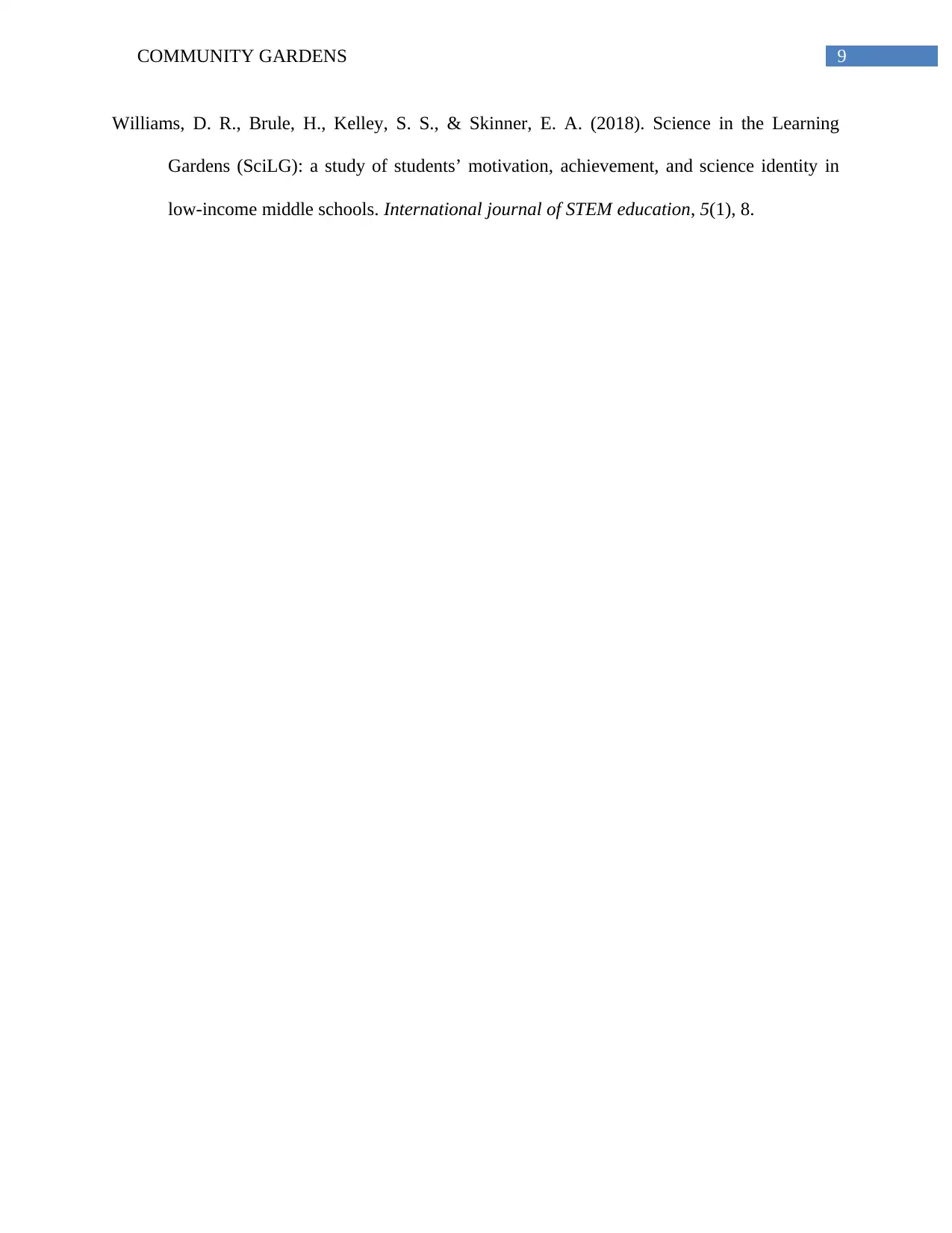
9COMMUNITY GARDENS
Williams, D. R., Brule, H., Kelley, S. S., & Skinner, E. A. (2018). Science in the Learning
Gardens (SciLG): a study of students’ motivation, achievement, and science identity in
low-income middle schools. International journal of STEM education, 5(1), 8.
Williams, D. R., Brule, H., Kelley, S. S., & Skinner, E. A. (2018). Science in the Learning
Gardens (SciLG): a study of students’ motivation, achievement, and science identity in
low-income middle schools. International journal of STEM education, 5(1), 8.
Secure Best Marks with AI Grader
Need help grading? Try our AI Grader for instant feedback on your assignments.
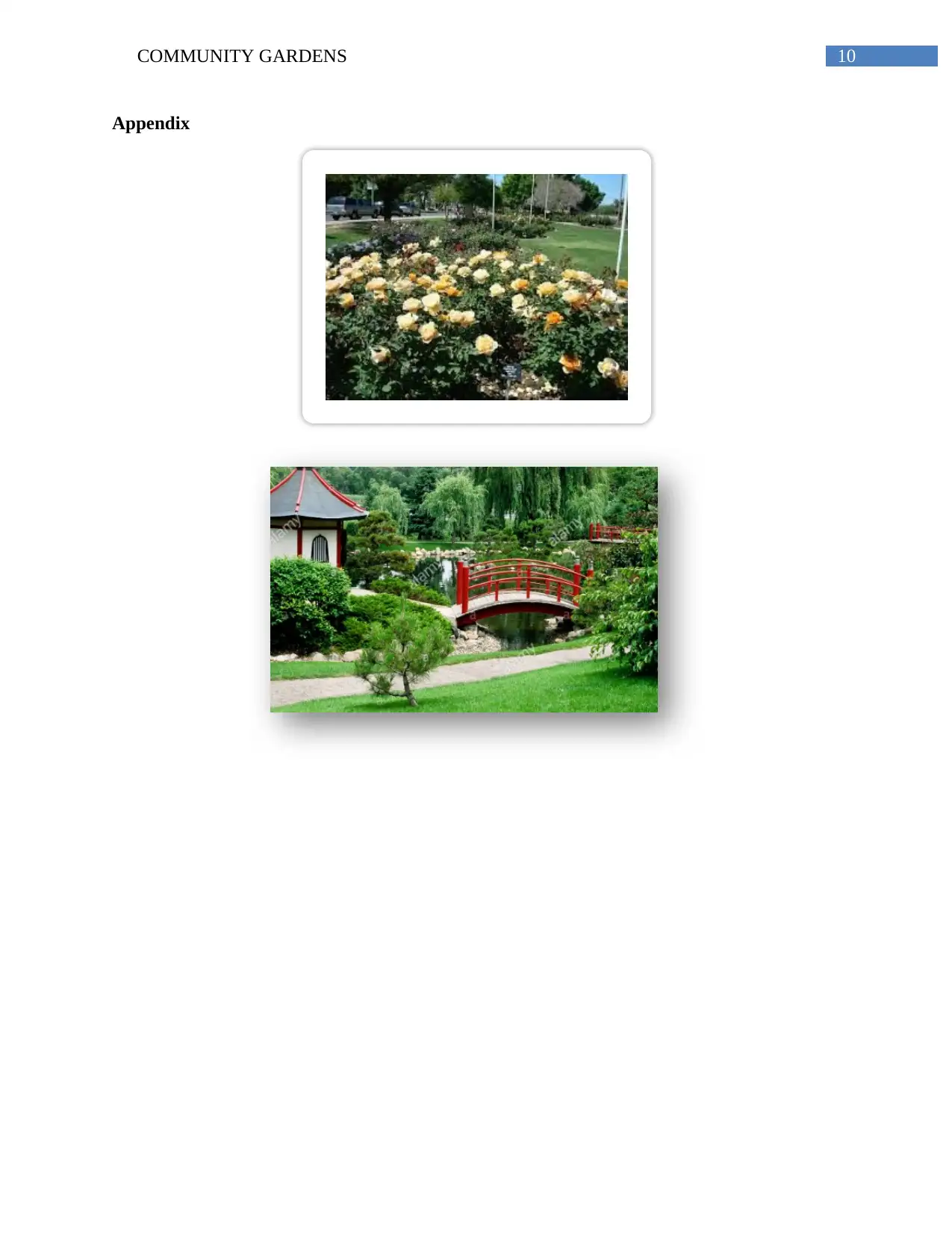
10COMMUNITY GARDENS
Appendix
Appendix
1 out of 11
Your All-in-One AI-Powered Toolkit for Academic Success.
+13062052269
info@desklib.com
Available 24*7 on WhatsApp / Email
![[object Object]](/_next/static/media/star-bottom.7253800d.svg)
Unlock your academic potential
© 2024 | Zucol Services PVT LTD | All rights reserved.